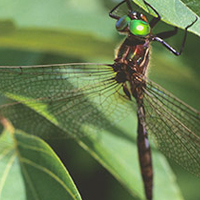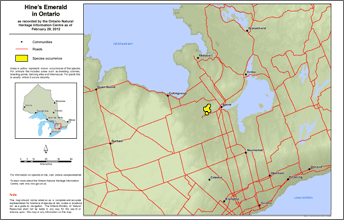Hine’s emerald
Scientific name: Somatochlora hineana

Cover photo credit: Jane and John Balaban
Status
Endangered
“Endangered” means the species lives in the wild in Ontario but is facing imminent extinction or extirpation.
Date added to the Species at Risk in Ontario List
January 13, 2012
Read the Assessment Report
What it looks like
Hine’s Emerald is a medium-sized dragonfly (about 60 millimetres long) with bright green eyes, a metallic green thorax with two lateral yellow stripes, and a blackish-brown abdomen.
Where it lives
Hine’s Emerald lives in groundwater-fed wetlands with grassy vegetation.
Larvae use crayfish burrows during periods of low water and during the winter.
Where it’s been found in Ontario
In Ontario, Hine’s Emerald has been documented in and around Minesing wetland in Simcoe County (west of Barrie). It is also found in Wisconsin, Michigan, Illinois and Missouri.
View a Larger version of this map (PDF)
What threatens it
This dragonfly is threatened by changes to water level fluctuations and quality in wetlands.
The European Common Reed, an invasive species which forms dense stands in fens, virtually eliminating native biodiversity, threatens the only Ontario site for this species.
Action we are taking
Endangered Species and their general habitat are automatically protected
Recovery strategy
A recovery strategy advises the ministry on ways to ensure healthy numbers of the species return to Ontario.
Read the executive summary (January 11, 2013)
Read the recovery strategy (January 11, 2013)
Government response statement
A government response statement outlines the actions the government intends to take or support to help recover the species.
Read the government response statement (October 11, 2013)
Five-year review of progress
A five-year review of progress made toward protecting and recovering a species is required no later than five years after the government response statement for that species is published.
Read the report on progress towards the protection and recovery of 17 species at risk, including the Hine’s Emerald (2018).
Habitat protection
A habitat regulation defines a species’ habitat and may describe features (e.g. , a creek, cliff, or beach), geographic boundaries or other unique characteristics.
Read the habitat summary (January 1, 2015)
Read the regulation (January 1, 2015)
What you can do
Report a sighting
- Report a sighting of an endangered animal or plant to the Natural Heritage Information Centre. Photographs with specific locations or mapping coordinates are always helpful.
Volunteer
- Volunteer with your local nature club or provincial park to participate in surveys or stewardship work focused on species at risk.
Be a good steward
- Private land owners have a very important role to play in species recovery. If you find Hine’s Emerald on your land, you may be eligible for stewardship programs that support the protection and recovery of species at risk and their habitats.
- The European Common Reed and Glossy Buckthorn, both invasive species, are serious threats to the Hine’s Emerald. To learn what you can do to help reduce the threat of invasive species, visit:
Report illegal activity
- Report any illegal activity related to plants and wildlife to
1-877-TIP-SMNR (847-7667) .
Quick facts
- Hine’s Emerald lives for three to five years, spending most of that time underwater as larvae.
- This dragonfly was only recently recorded in Ontario, with the first documented sighting in 2007.
